Oven-baked and shaped in a cylinder, Datemaki or Japanese Sweet Rolled Omelette is a must-have Osechi Ryori dish on New Year’s Day. Similar to tamagoyaki, this sweet-savory omelette is tender and moist inside with a golden brown exterior and sunny shape.
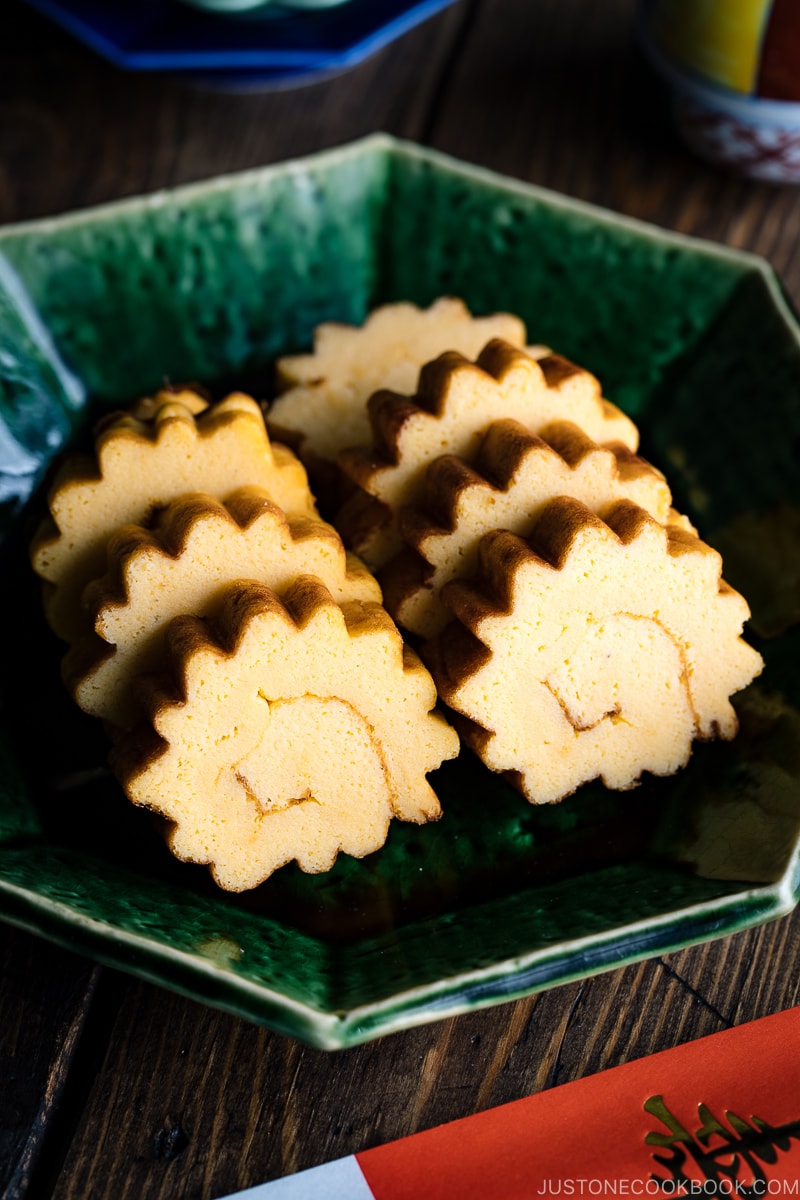
Datemaki (伊達巻) is a traditional sweet rolled omelette typically eaten as part of Japanese New Year’s food (osechi ryori, 御節料理). Served in a lacquered jubako (special square boxes similar to lunch boxes), it is made with eggs mixed with fish or shrimp paste and sweetened with sugar and mirin.
Among all the dishes for osechi ryori, datemaki often stands out for its bright sunny color and unique shape. It is by far my favorite dish among the new year foods and I always look forward to eating it every year. The sweet and savory flavor and almost cake-like texture make it a popular choice for the whole family!
You can often find pre-made datemaki being sold at Japanese grocery stores during this time of the year, but it is really easy to make it from scratch. I’ll show you how to achieve the perfect datemaki at home.
Table of Contents
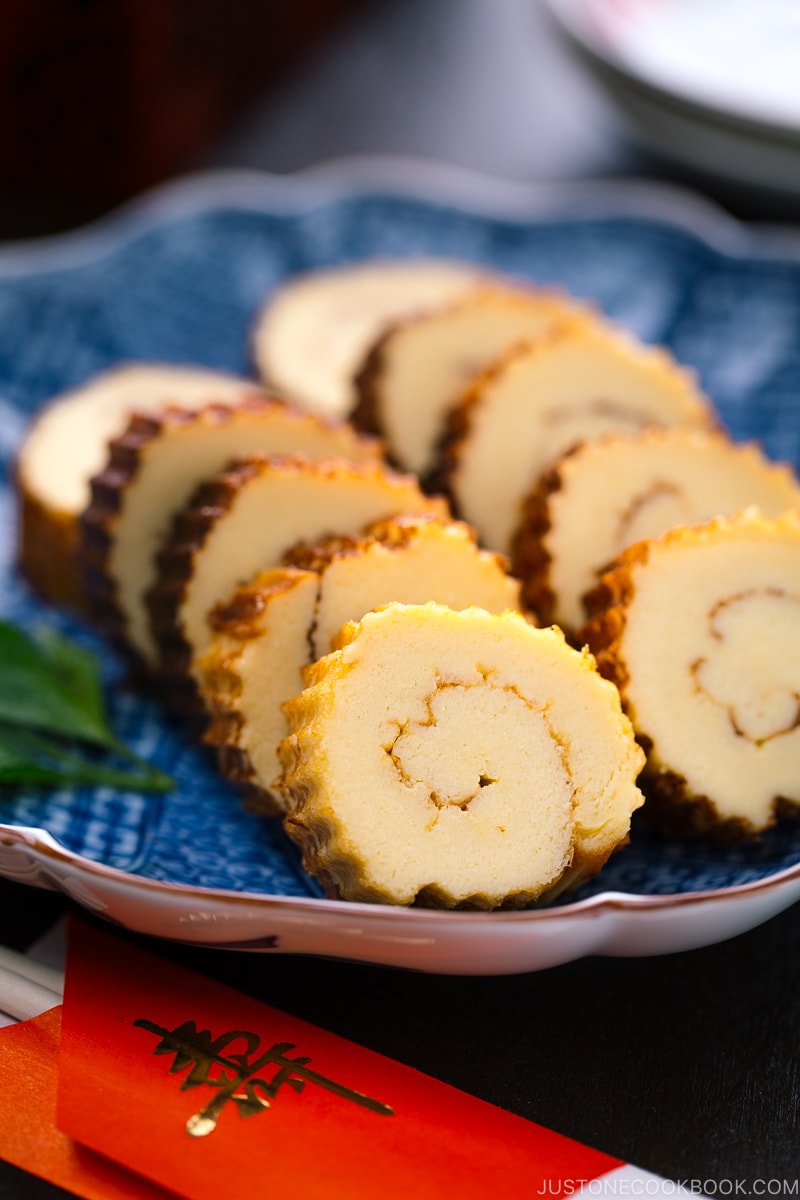
What is Datemaki
Datemaki is a must-have New Year’s food in Japan. It is similar to Tamagoyaki as both are rolled omelets with similar ingredients. The main difference is datemaki features a type of white fish cake called hanpen. Hanpen is made from grated Japanese yam (yamaimo) and surimi (Alaska Pollock), salt, and kombu dashi. It adds a unique flavor and a fluffy texture to the egg omelette, like a soft fish cake.
There are also other differences between datemaki and tamagoyaki:
- Instead of cooking on a pan over the stove, datemaki is baked in the oven in a single layer before being rolled into a cylinder and sliced. Just like baking a cake!
- Compared to tamagoyaki, datemaki is a little sweeter and is usually eaten only for the New Year.
The Symbolic Meaning of Datemaki
There are many different theories behind the symbolism of datemaki, but it is most commonly believed that eating datemaki will bring a good year of wisdom and learning, and success in studies (especially for student life). The rolled shape of datemaki is reminiscent of a scroll, which is historically a symbol of knowledge.
When I was a student, my mom would make sure that my brother and I had our good share of datemaki.
Another story was that the rolled fish cake omelet looked like a colorful kimono that fashionable people wore during the Edo period. As the word “date” refers to the sash for Japanese kimono and ‘maki’ means rolled, this is where the omelet got its name from.
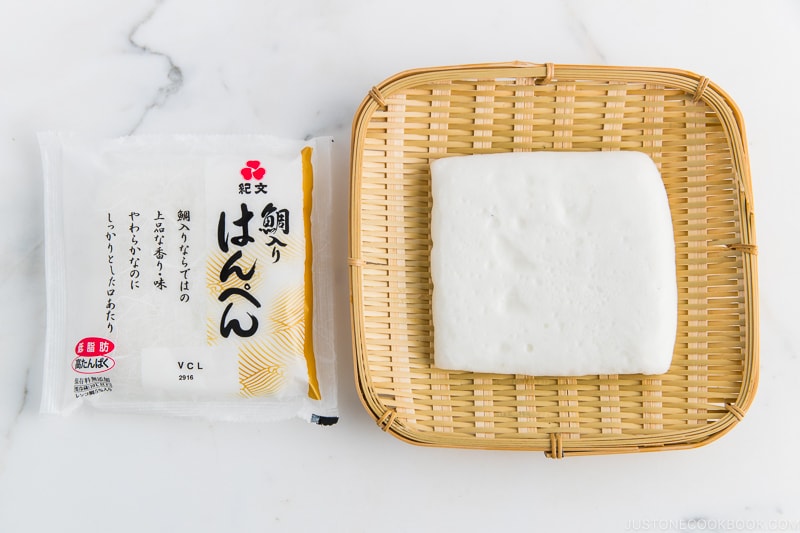
Ingredients You’ll Need to Make Datemaki
- Eggs
- Hanpen fish cake – You should be able to find hanpen in the freezer section at most Japanese grocery stores. Alternatively, you can substitute it with pureed white fish, scallops, or shrimp.
- Mirin
- Sake
- Sugar – Datemaki is meant to be sweet, but you can cut down the sugar slightly if you prefer.
- Honey
- Soy sauce
Many datemaki recipes require dashi, but I find it not necessary as hanpen is made of kombu dashi and it already adds a nice flavor to the omelette. Of course, you can always add dashi if you like.
After blending all the ingredients for the egg mixture, it is then baked until firm and nicely browned on the outside.
Helpful Tool to Roll the Omelette
You have probably seen or used makisu (巻き簀), a bamboo mat, to roll sushi or stabilize the shape of Tamagoyaki. For the decorative purposes, we use this special bamboo mat called onisudare (鬼簾, 鬼すだれ) for datemaki. This rolling mat has deep notches that gives the signature zigzag marks on the surface of the omelet.
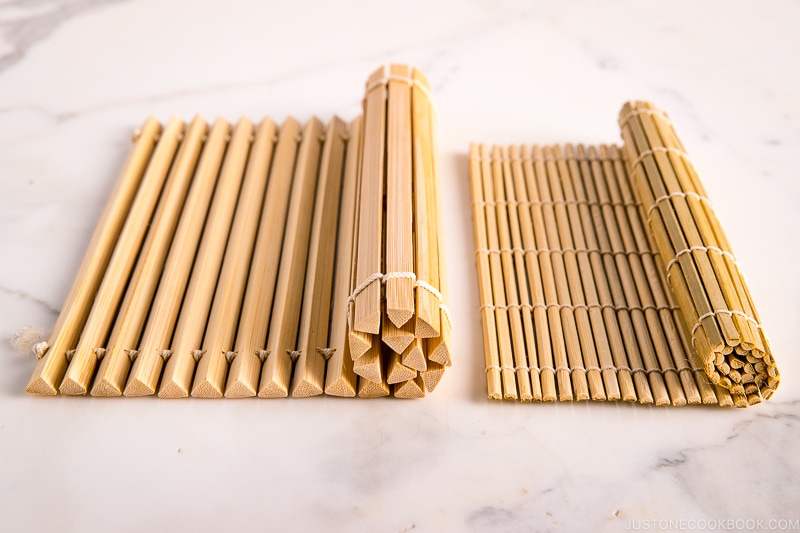
If you don’t have onisudare, you can still use a regular bamboo mat to give a similar effect to datemaki. The ridges are less striking but they still look pretty (see the right picture below).
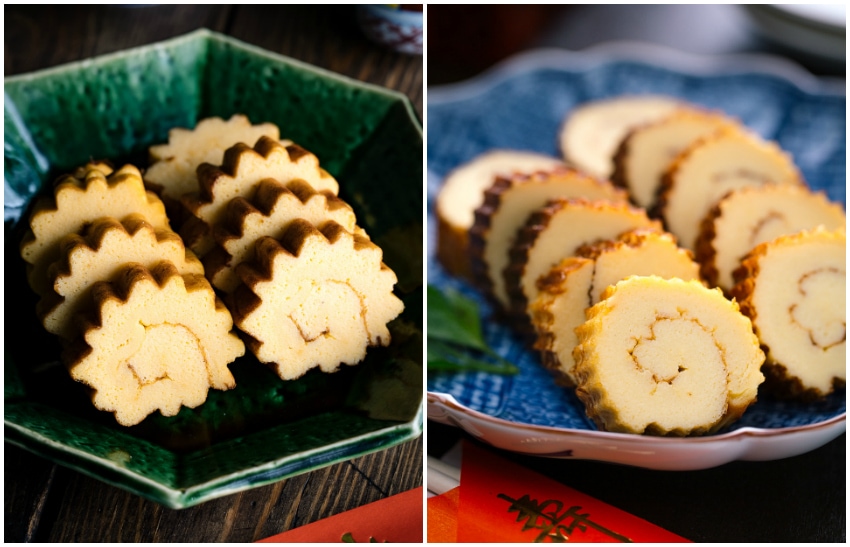
Quick Tips For Making Datemaki
- Strain the egg mixture through a fine sieve will yield a smooth, airy, and fluffy texture.
- The final texture of datemaki should be tender and moist in the middle and the top golden brown. Watch your oven toward the end of baking. If the top is not golden brown, switch to a broiler and broil for 2 minutes.
- Roll the omelette while it is still hot and gently score the omelet before you roll. This will help the omelette roll up easily without cracking.
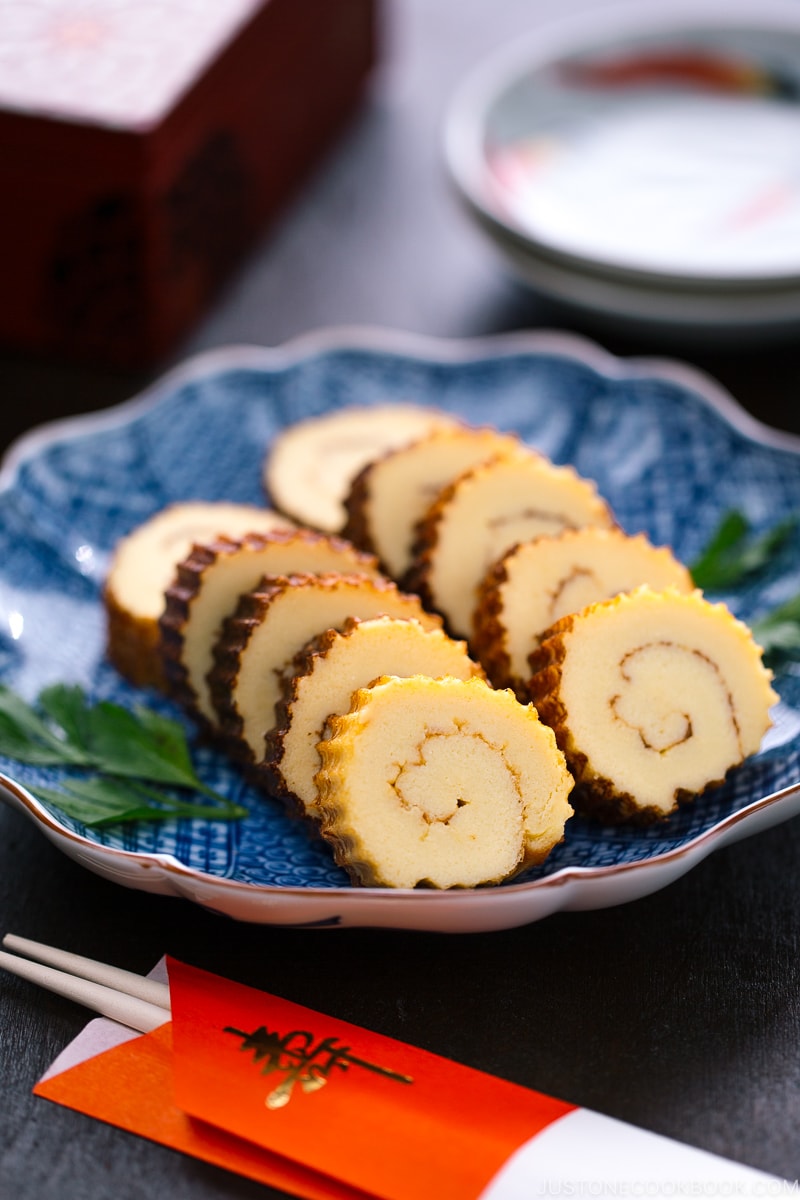
Perfect Make-Ahead Dish for Osechi
Datemaki is meant to be served at room temperature. Since it stores well in the refrigerator for 4-5 days, you can slice it and keep them in an airtight container or reusable plastic bag.
More Easy Japanese New Year Recipes
- Tazukuri (Sweet Soy Glazed Sardines)
- Instant Pot Kuromame (Black Soy Beans)
- Sekihan (Red Bean Rice)
- Namasu (Daikon & Carrot Salad)
- Yellowtail Teriyaki
- Butter Shoyu Scallops
- Inari Sushi
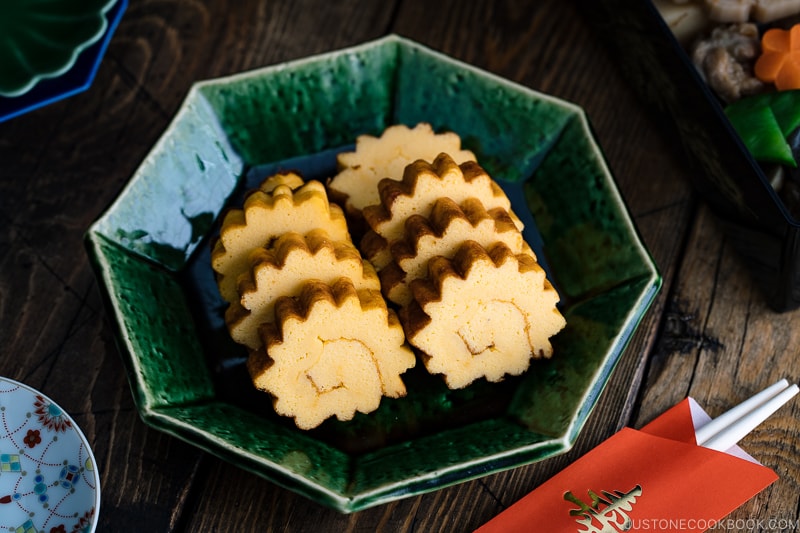
Wish to learn more about Japanese cooking? Sign up for our free newsletter to receive cooking tips & recipe updates! And stay in touch with me on Facebook, Pinterest, YouTube, and Instagram.
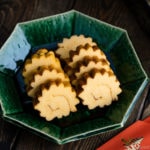
Datemaki (Sweet Rolled Omelette)
Video
Ingredients
- 1 package hanpen (fish cake) (110–130 g or 3.9–4.6 oz; found in the refrigerated or frozen section of a Japanese grocery; if you cannot find it, substitute puréed white fish (skinless/boneless), scallops, or shrimp)
- 4 large eggs (50 g each w/o shell)
Instructions
- Before You Start: If you will include this dish in your Osechi meal, I recommend cooking it 2 days before you plan to serve. For more helpful tips on planning your Japanese New Year feast, please read my A 5-Day Osechi Cooking Timeline blog post.
- Gather all the ingredients. You will need parchment paper and a bamboo sushi mat. In Japan, we use a special bamboo mat with thicker strips called onisudare, which makes big ridges or indentations on the Datemaki.
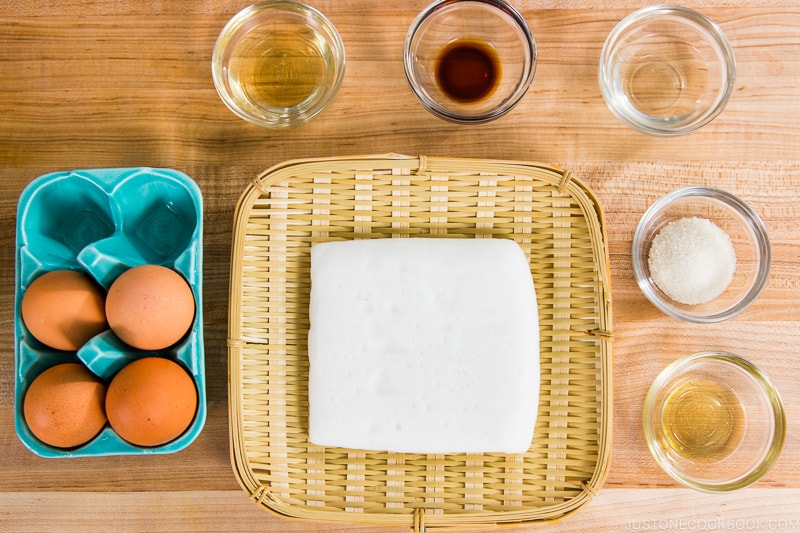
- Preheat the oven to 400ºF (200ºC). For a convection oven, reduce the cooking temperature by 25ºF (15ºC). Line an 8 x 8-inch (20 x 20-cm) baking dish with parchment paper.
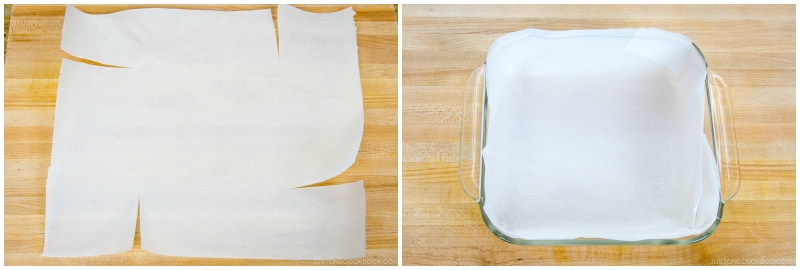
To Prepare the Ingredients
- Cut 1 package hanpen (fish cake) into ½-inch (1.3-cm) cubes. Next, whisk 4 large eggs (50 g each w/o shell) in a small bowl.
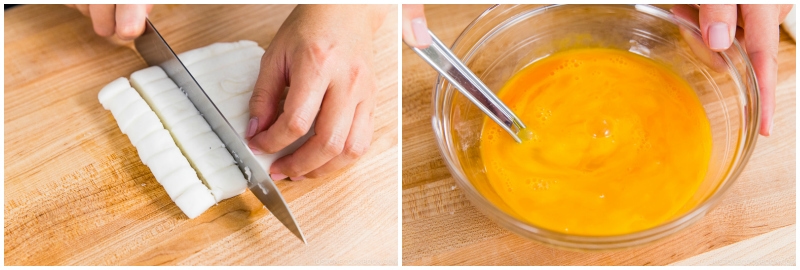
- To a blender or food processor, add the hanpen and all the seasonings: 2 Tbsp mirin, 1 Tbsp sake, 1 Tbsp sugar, 1 tsp honey, and ½ tsp soy sauce.
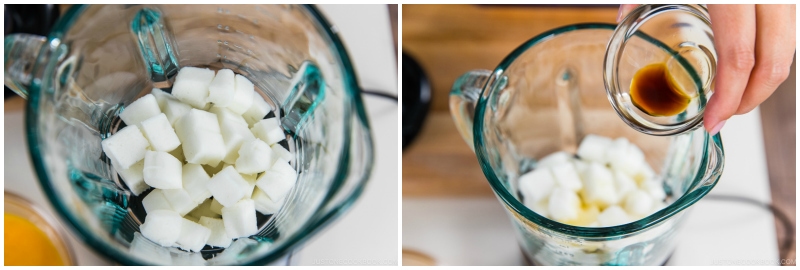
- Add the beaten egg and blend until smooth, about 1 to 1½ minutes.
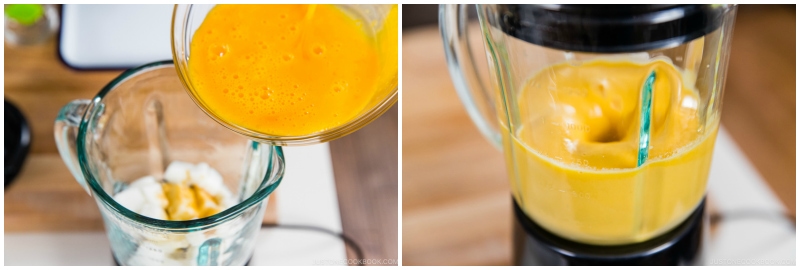
- Strain the egg mixture through a fine-mesh sieve into a clean bowl. You can use a spatula to help pass the mixture through the sieve.
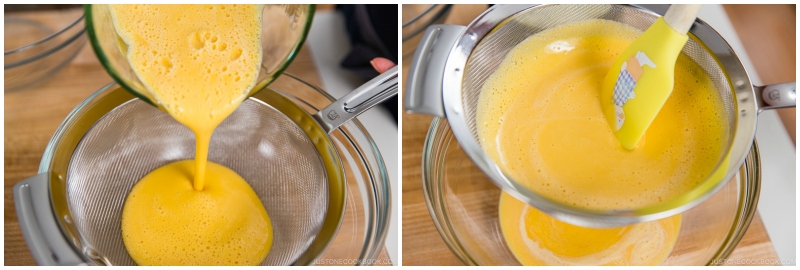
- Then, pour the mixture back into the blender jar and strain it one more time into the bowl. Finally, pour the strained mixture into the baking dish lined with parchment paper.
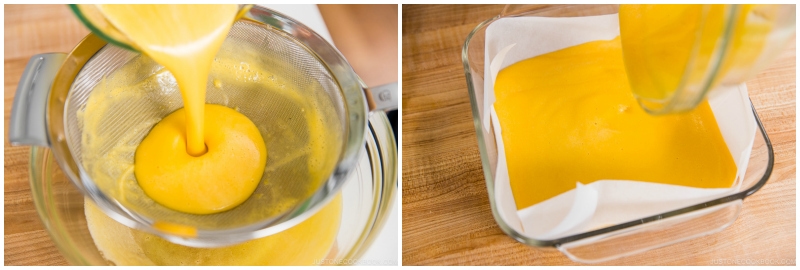
- Bake at 400ºF (200ºC) for 20 minutes or until slightly brown on top. If the top is not golden brown, switch to the Broiler setting and broil for 2 minutes or until the surface is golden brown. The center of the omelette will rise slightly as the top gets brown. It will shrink as it cools.
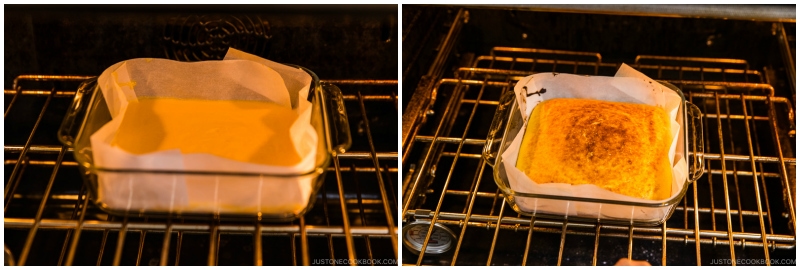
To Roll the Datemaki
- Remove the baking dish from the oven. Let the omelette deflate and rest until it's just cool enough to handle, only for 1–2 minutes (DO NOT LEAVE IT LONGER than that). We will need to roll the omelette while it’s still hot.
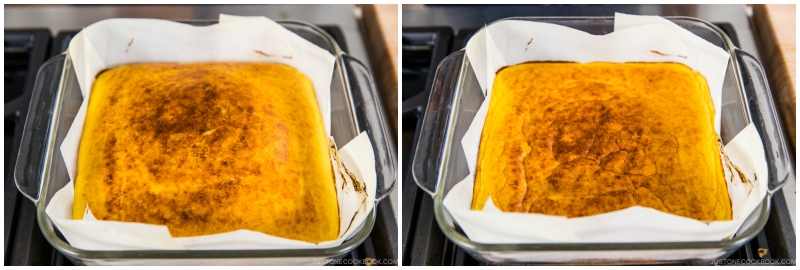
- Lift the omelette from the baking dish using the parchment paper and transfer it to a work surface. Then, place the bamboo mat over the omelette, with the flat side of the bamboo facing up.
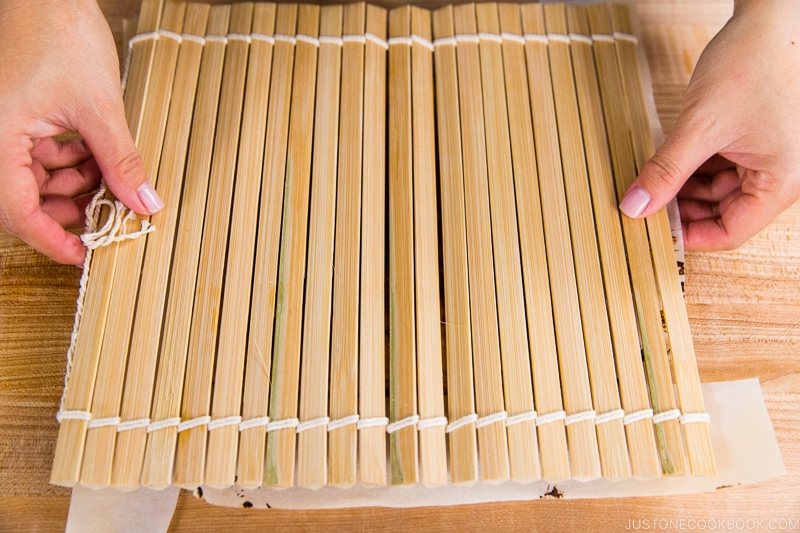
- Hold the omelette between the bamboo mat and the parchment paper. Then, carefully flip over the omelette onto the bamboo mat. Remove the parchment paper.
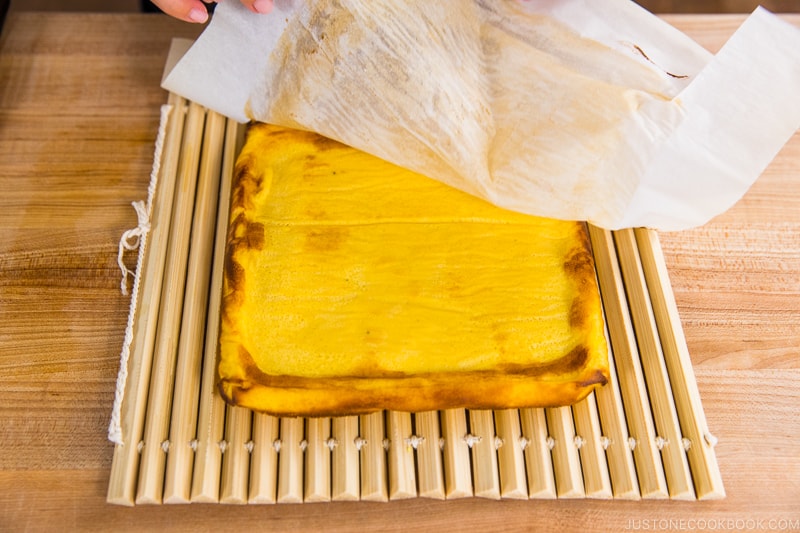
- Now, score the omelette: Rotate the bamboo mat so the slats line up with the direction of your knife. Starting at one edge, use a knife to carefully score along the length of the omelette about ⅛ inch (3 mm) deep. Make sure the knife is parallel to the slats of the bamboo mat. Repeat, scoring the omelette lengthwise every ½ inch (1.3 cm) until you reach the other edge. Tip: These incisions will help the omelette roll up without breaking or cracking.
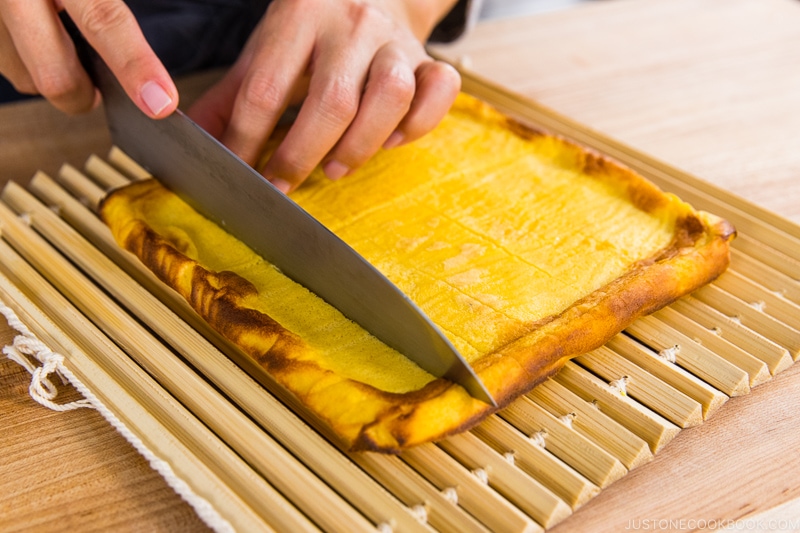
- Use the bamboo mat to roll the omelette into a tight cylinder. Then, continue to roll the bamboo mat tightly around the omelette to help hold its cylinder shape.
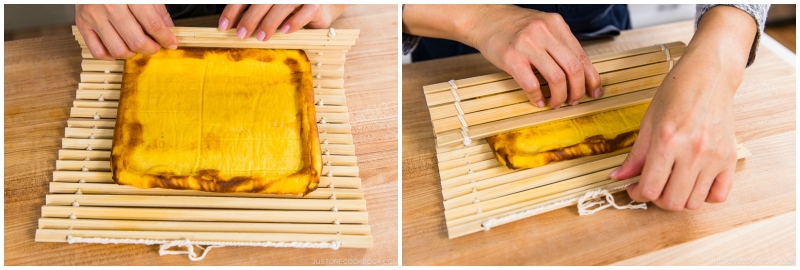
- Secure the bamboo and omelette roll with rubber bands so they hold the omelette cylinder firmly and tightly in place. Then, wrap it with plastic wrap. Let it cool completely for 2–3 hours.
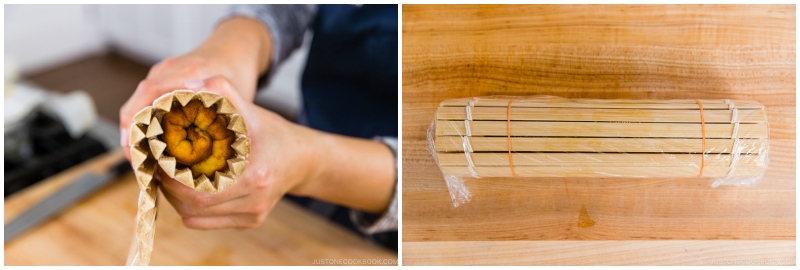
To Serve
- Once cooled, carefully remove the Datemaki from the bamboo mat. Cut crosswise into 12 equal slices about ¾ inch thick. Serve at room temperature.
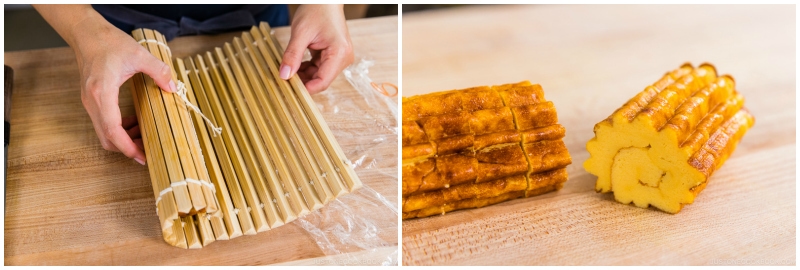
To Store
- You can keep the leftovers in an airtight container and store it in the refrigerator for 4–5 days.
Nutrition
Editor’s Note: This post was originally published on Dec 26, 2013. The pictures have been updated in December 2019. The post has been republished on December 2023.
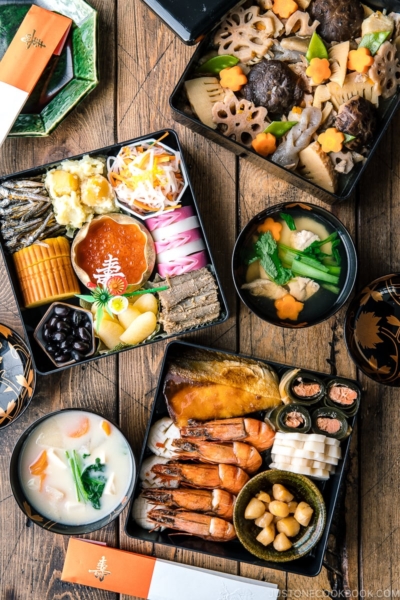
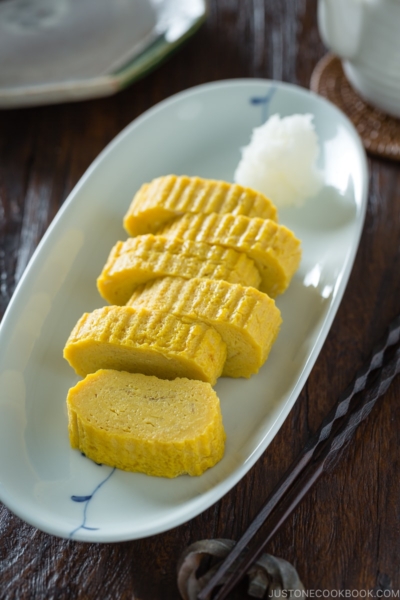
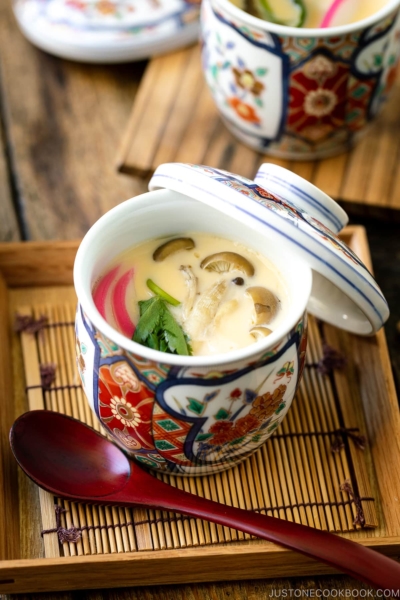
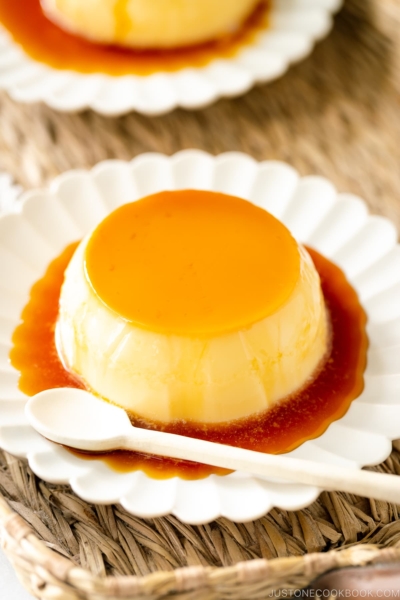
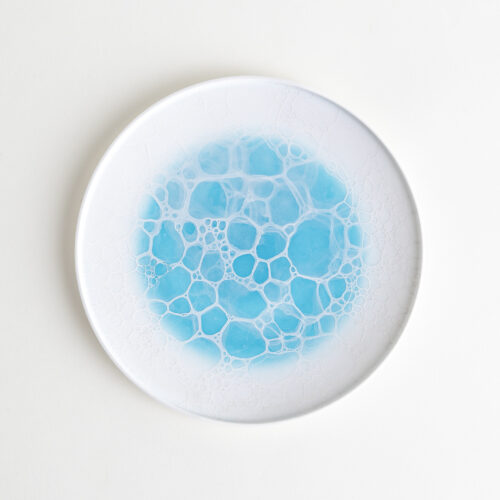
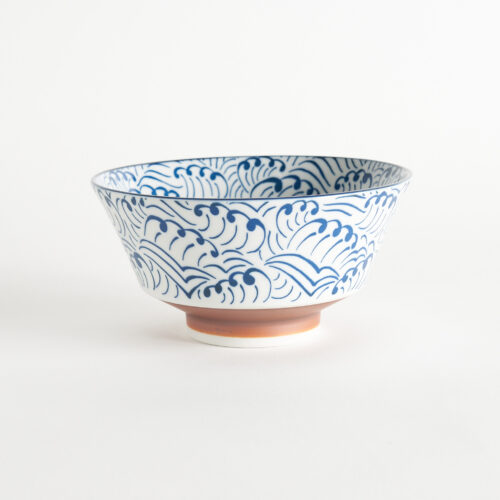
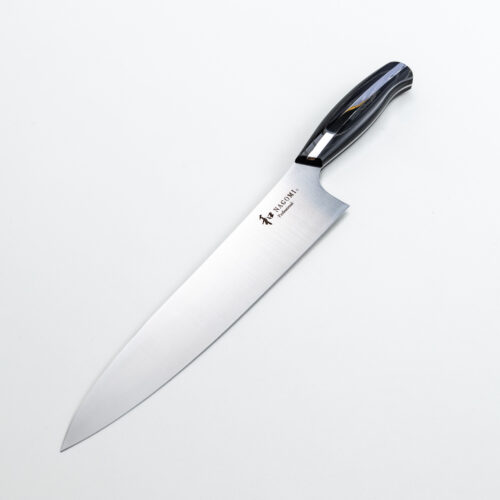
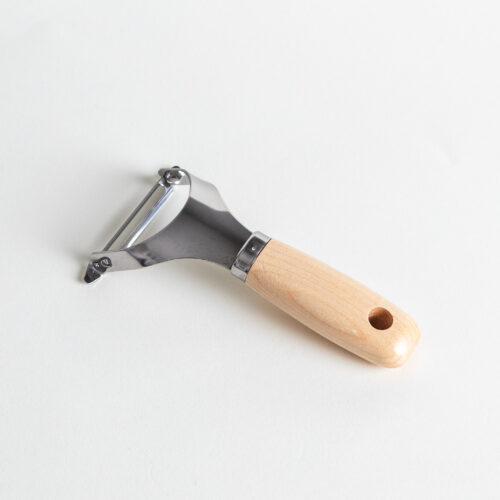

I made some of your New Year’s recipes for my Japanese husband:.sweet potato with chestnuts, sweet rolled omelette (I put spinach in the middle); daikon /carrot salad; simmered chicken with vegetables; and simmered shrimp. I kept him out of the kitchen so he wouldn’t see what I was making. When he came to the New Year’s table, he patted his heart and said, “I am in Japan!.” Thank you, Nami-san!!! P.S. I have written a cookbook “Off The Grid, What’s Cookin’?” which includes many JP recipes, especially mozuku – so delish. Feel free to use any of them in your blog if you can give me credit. Thanks again, big time!!!
Hi Lynne! So happy to hear your husband was impressed with your osechi! You did an amazing job! And how cute that you were hiding all the dishes you were cooking. 😀 So sweet! Thank you for introducing your cookbook. I had many delicious mozuku dishes when I was visiting in Okinawa this past week. So delicious!
I made this for New Year’s. It tasted great! But I had some issues with mine, and I’d love your help trying to solve them. I made my datemaki on Friday for Sunday. I actually made 2. I stored them in the fridge, still rolled up in the mats and wrapped in plastic. They didn’t go into the fridge until they were completely cooled. On Sunday, I set them out on the counter to get to room temperature, and then I unrolled. One fell apart into pieces right off. The other one had a crack, but I was able to work with it to keep it in tact.
My question is: should I have unrolled them 2-3 hours after they had been cooled and then rerolled and put in the fridge? In other words, not inside the mats?
Happy New Year to you and your family. Or as we say here, Hauoli Makahiki Hou!.
Hi Debbie! I’m glad you liked the taste! Now, let’s see about the issue. I usually keep it rolled in the bamboo wrappers until it’s ready to cut. I think it’s much easier to cut when it’s cold and tighten up. When it comes to room temperature, datemaki gets loose loose I think.
Hauoli Makahiki Hou to you and your family!
some of the ingredients are hard for me to get, do you have a recipe to make your own hanpen with a possible substitute for the yam? I know there is probably a place to order it (the link next to the item in ingredient list does not load for me), but if there is a way I can make it from scratch myself – I would prefer to. And sorry to be such a pest all the time.
Hi Lori! I understand. I think without a Japanese grocery store it’s quite difficult to gather ingredients to make traditional Japanese new year dishes. I’ve never tried it myself, but white fish paste, scallop or shrimp is supposed to work well as substitute. You can’t use just Nagaimo. I wrote Japanese Yam in the Note section, but I’m going to change it to Nagaimo or Yamaimo as it’s not regular yam. It’s more like sticky and gooey and slimy yam, and saying Japanese yam might be a bit confusing. We use this slimy yam as “binding agent” not as a main ingredient. 🙂
Mmm, I can’t wait to try making this! I wonder, have you ever tried freezing these for easy use in bentos?
Hi Candice! I hope you enjoy this recipe! You can definitely freeze this. Before the New Years, Japanese grocery stores start to sell frozen Datemaki from Japan. 🙂
I have a question. I was thinking of making datemaki for New Year’s, but I probably need to make it the night before. Would it be OK to make it on New Year’s Eve and refrigerate it? I live in a warm climate, so I don’t think I would be able to leave it out on the counter. I could take it out of the fridge an hour or two before serving.
Hi Debbie! Yes, we usually make osechi the night or 2 days before for some ingredients. Osechi is seasoned stronger to keep it for several days (so that women in the family don’t need to cook on New Year’s Day etc). Datemaki is actually good even it’s cold, so you can definitely make this ahead, and then serve on New Year’s Day… by the time you eat, it should be around room temp, too. 🙂
Using the easiest to find type of surimi in the US, “artificial” or “imitation” crab meat, turns out almost as tasty as using the harder to find (and more expensive when ordered online) hanpen. I added 1tbsp of homemade dashi to compensate for the less intense flavor of the artificial crab meat. The texture is slightly different than when hanpen is used, but it’s fairly close and much easier to find for me.
Delicious recipe, and so easy!
Hi PK! I’m glad to hear surimi works fine! Thank you for your tips, my readers and I appreciate your feedback!
I make tamagoyaki but haven’t tried making this variation. We just went to Mitsuwa yesterday. I wish I had checked out this recipe before we went so I could pick up some fish cake. I think my daughter will be there on New Year’s Day, so I’ll have her get me some. I’d really like to make this for the new year.
Hi Linda! I know, unlike Tamagoyaki, this Datemaki requires the hanpen (fish cake)…. it’s hard to make it without planning. 🙁 I hope you like this recipe. It tastes amazing! 🙂
When you say to keep the bamboo mat straight while cooling to maintain the round shape, do you mean to cool it standing up vertically? Thanks! Your recipes are making our New Year’s dinner even better!
Hi Karen! Yes “vertically” so one side of round shape won’t be flat. I’ll edit my recipe later. I can’t believe I forgot to take the picture of the process. Thank you for asking. Hope you enjoy this recipe! Happy New Year to you and your family!
OMG! You make it look so easy. I cant wait to try it now. Thank you for the demo. That helped me!!
Hi Pamela! I hope you enjoy the recipe! 🙂
nami, i have ben continually impressed with justonecookbook. It is such a treat to see how you grow and get better and better! I have been a Japanophile for 30 years, and I love the choices you make for the recips you cover. I was thinking about this particular recipe and how i would make it if i were doing lots and lots of rolls, instead of just one. (Can you tell I owned a catering company for 30 years?!) I think i would place a piece of plastic wrap over the bamboo mat, with the plastic wrap hanging over the left and right side about2-3 inches. I would put the cooked egg square on the plastic wrap with the browned side up, lay a sheet of nori the same size- over the egg, and roll it up tightly, removing the bamboo mat at the end and twisting the ends of the plastic wrap , one one direction and the other the other direction, to make the roll tight, and then chill, remove the wrap, and slice. And maybe present with a little tobiko in the middle (the nori and the tobiko making up for the scalloped edge that would have been imprinted if the roll had been done your way, in the bamboo mat. Thanks for the inspiration, Nami!
(That plastic wrap end- twisting technique is what i use when I make poached chicken or seafood ‘sausages’, for making the roll both tight and watertight. When sliced, the spirals come out very neat!))
Thank you so much for your kind words and I’m so happy to hear that you enjoy my recipes. 🙂 30 years of catering experience is amazing! I am not very good at cooking for many people. I get very nervous when I have to feed many people. xD I need to learn some trick and tips from you!
As for datemaki, one thing I should mention is the shape. You see the wavy decoration around datemaki? It’s signature look. So if you want to keep that, you may need to leave the bamboo with the roll… but if you don’t mind, you should be okay with the plastic wrap method!
Thank you for your comment! 🙂
Hi I Have a question-if we substitute happen with white flesh, do we blend the fish raw, or cooked with the egg? Thanks!
Happy New Year Mizuki! I apologize for my late response due to my travel. We use raw fish (or surimi). 🙂
Thank you for the recipe, it looks really good, Nami! Shinnen Omedeto gozaimasu to you and family!
Akemashite Omedeto, Marguerite! I’m glad to hear you like the recipe. 🙂 Arigato!
Oh Nami, these look beautiful! And easier to make than the tamagoyaki that gave me such trouble!
I wonder though, can you suggest a vegetarian substitute for the hanpen? Or shall I just leave it out altogether?
My best wishes for a wonderful family New Year’s Eve, and a very happy 2014!
Happy New Year Ina! So sorry for my late response. You have a good question! I actually never made or thought of vegetarian version and I’m not sure how we can substitute the fish cake (or shrimp/scallop/fish). It needs similar texture – do you think tofu would work? Sorry I can’t help much… Hope you have a wonderful 2014 too!
Good suggestion, thank you. Maybe a soft tofu. I think I’ll just add a little extra soy sauce to disguise the tofu taste a little, though!
And thank you too, Nami, for telling me how the Japanese put sugar in their omelets. That is truly delicious, who would have thought?! I’ll never make a salty egg dish again!
Yeah soft tofu. I love sweet egg since I was small. Tamago/egg sushi, shredded egg crepes over chirashi sushi, datemaki, tamagoyaki… love that sweet (not super sweet) flavor. 🙂
Me too!
Was it successful with Tofu? I am making the chicken meatballs this week and was thinking of making this with the excess tofu and wondered if anyone had already tried it. Thanks!
Happy New Year in beautiful New York. In April, we are going on a cruise from Los Angeles to Osaka. Our daughter was in Osaka in 1995 during the big earth quake, but she loved the city. We are looking forward to our visit, even for one day.
Happy New Year Sandy! How exciting! I didn’t know there is a cruise that goes from LA to Osaka! It’s a nice season to visit Japan during that time. Have a great trip!
When I first saw the photo, I was wondering how you got those pretty indentations around the datemaki. =) This really seems like a simple and still delicious recipe; I can see how it can easily be a New Year’s favorite!
Thanks for continuing to share osechi ryori with us — the dishes look so elegant, and I love the image you shared of everyone pitching in to help for New Year’s preparations. Also, I’m glad to hear that your family is having fun in NYC! There’s a Japanese wagashi store called Minamoto Kitchoan that I always like to visit every time I’m in the city. Hope that you and your family enjoy a wonderful New Year’s!
Hi Kimmi! Happy New Year! There’s Minamoto Kitchoan in SF too, but I haven’t had a chance to visit SF store yet. I should check it out! I hope you had a wonderful holiday. 🙂